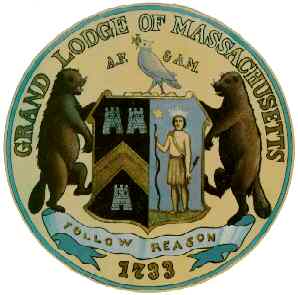- Grand Lodge of Massachusetts
Infobox_Grand_Lodge
name=Grand Lodge of Massachusetts A.F. & A.M.
motto-latin=
caption=Seal of the Grand Lodge of Massachusetts A.F. & A.M.
established=1733
jurisdiction=Massachusetts
grand-master=
location=Massachusetts
country=USA
website=http://www.massfreemasonry.org/The Most Worshipful Grand Lodge of Ancient Free and Accepted Masons of the Commonwealth of Massachusetts, or Grand Lodge of Massachusetts in short (GLMA) is the main governing body ofFreemasonry withinMassachusetts , and maintains Lodges in certain jurisdictions overseas, namelyPanama ,Chile , thePeople's Republic of China andCuba .It is considered to be the third oldest Masonic Grand Lodge in existence (after the
United Grand Lodge of England (which dates its own existence from the formation of the Grand Lodge of England in 1717), and theGrand Lodge of Ireland (1725)), interpreting the 1733 warrant, creatingHenry Price the Provincial Grand Master ofNew England , as the creation of the Grand Lodge of Massachusetts.Price's successors as Provincial Grand Master,
Robert Tomlinson ,Thomas Oxnard ,Jeremy Gridley and John Rowe, were all appointed (in 1736, 1743, 1755 and 1768 respectively) by the Moderns' Grand Master inLondon . The Provincial Grand Lodge, which, due to theAmerican Revolution , held no meeting during the period 1775 to 1787, finally merged with its counterpart Antient Provincial Grand Lodge, created in 1769 by theGrand Lodge of Scotland . On the date of that merger,5 March 1792 , the newly created body first exercised its new sovereign powers by electing a Grand Master in the person ofJohn Cutler , and by adopting the name "The Grand Lodge of the Most Ancient and Honorable Society of Free and Accepted Masons of the Commonwealth of Massachusetts".First Provincial Grand Lodge
Freemasonry in Massachusetts dates to the early 18th century, and the foundation of its Grand Lodge is wound through with the threads of the (then) ongoing disputes between the Moderns and the Antients.
After the formation of the
Premier Grand Lodge of England (later referred to as the Moderns) in 1717, and the amalgamation of individual Lodges into that body, Lodges and Masons in the Boston area asked one Brother Henry Price to go to London, and petition the Grand Lodge for a Warrant in order to be considered regular, in accordance with a regulation dated in 1721.Price did so, and returned in the spring of 1733 with more than just a Warrant for an individual Lodge - he was made the "Provincial Grand Master of New England and Dominions and Territories thereunto belonging" by the Grand Master, The Right Honorable and Right Worshipful Anthony Browne, 6th Viscount Montague.
This Provincial Grand Lodge was historically known as St. John's Grand Lodge, and chartered numerous Lodges in the Colonies. The first one, which was chartered in Boston, was known and recorded as First Lodge in the English rolls of 1734, and is now known as St. John's Lodge.
Scotland, Ireland, and the Antients
In a manner similar to the creation of St. John's Grand Lodge, a number of Masons who had been active in the "Antients" style of Freemasonry grouped together, and petitioned the
Grand Lodge of Scotland for a warrant, which was given to "The Lodge of St Andrew" in 1756. These Antient Freemasons, desiring equal stature with the Moderns, joined with the Lodges attached to three British military units in petitioning the GL of Scotland for Provincial GL status::Lodge of St. Andrew (Scotland):British Army Lodge #58 (Antient) in the 14th (Irish) Regiment of Foot:Glittering Star Lodge #322 (Ireland) with the 29th Regiment:Lodge Number 106 (Scotland) with the 64th regiment (which left before the inauguration of the GM, Joseph Warren) [ [http://www.phoenixmasonry.org/the_builder_1918_october.htm "The Builder" magazine, October 1918] ]
Due to the Revolution, and based on the state of affairs between the US and Great Britain, the Scottish Provincial Grand Lodge drafted "new" constitutions, breaking from the Grand Lodge of Scotland and becoming Massachusetts Grand Lodge in 1782.
There was a growing rift in the Lodge of St Andrew regarding this decision to separate, and in December of that same year, it came to a vote.Thirty Masons voted to stay part of the Grand Lodge of Scotland, and nineteen voted for the Massachusetts Grand Lodge. No action was taken on this vote, and it was laid on the table until the end of the war. In January 1784, they voted again, with twenty-nine voting for Scotland, and twenty-three for Massachusetts. Those voting for membership in the Massachusetts Grand Lodge were expelled from the Lodge of St. Andrew. However, they formed their own Lodge of St. Andrew under the new Massachusetts Grand Lodge, which caused confusion for some time, until it was renamed Rising States Lodge.
References
* [http://web.archive.org/web/20060502164554/http://www.glmasons-mass.org/Grand_Lodge/WHO/history.htm History of the Most Worshipful Grand Lodge of Ancient Free and Accepted Masons of the Commonwealth of Massachusetts]
External links
* [http://www.massfreemasonry.org/ The Grand Lodge of Masons in Massachusetts]
Wikimedia Foundation. 2010.
